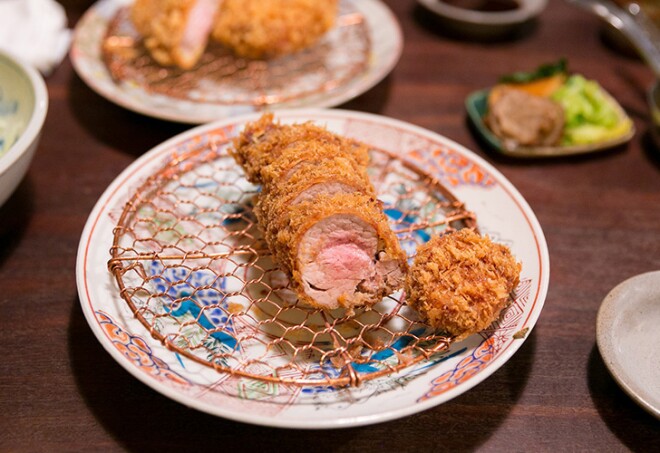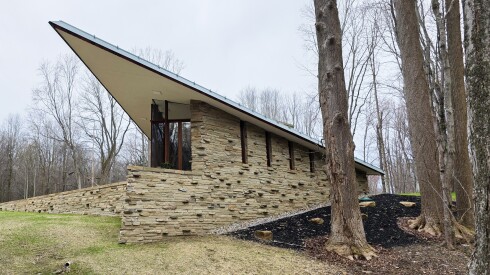Where to Eat in Tokyo
With more Michelin-star restaurants—200—than any other city, Tokyo is an unrivaled culinary capital. It’s a good idea to have your hotel’s concierge make a reservation, though, because many top restaurants have only a few, very coveted tables.
Japan, 〒160-0023 Tōkyō-to, Shinjuku-ku, Nishishinjuku, 1 Chome−13−7 大和家ビル 9F
Hiroyasu Kayama is both scientist and bartender at this bar on the ninth floor of an office building. Kayama has a collection of dried herbs, spices, and even bugs on the shelves behind the bar. The best seats are at the counter, where you can watch as Kayama creates from scratch a Campari using cochineal insects. To witness the red color come to life gets your mouth wet for the drink that awaits. The absinthe made with wormwood should also be on your radar. Best to tell Kayama what cocktails you like and let him recommend something for you.
The bartenders at Ben Fiddich don’t complicate your experience with a menu. Tell them your mood and sit back while they craft something according to their whim. Say, a whiskey drinks filled with burnt herbs whose smoke steams your glass or a homemade Campari Negroni.
The bartenders at Ben Fiddich don’t complicate your experience with a menu. Tell them your mood and sit back while they craft something according to their whim. Say, a whiskey drinks filled with burnt herbs whose smoke steams your glass or a homemade Campari Negroni.
1 Chome-1-1 Uchisaiwaichō, Chiyoda-ku, Tōkyō-to 100-8558, Japan
The Old Imperial Bar is an old-school Tokyo bar favored by some of Japan’s political and financial elite, who come for its demure and consistent service. The popular bar snack kaki pi—spicy rice crackers and peanuts—originated here and is still being served. Soak in the nods to Frank Lloyd Wright, who designed the original hotel: the Hopi-inspired carpet design, the terra-cotta grillwork, and the polychrome and gold-leaf fresco on the wall in the back of the room. Classic cocktails reign, such as a gin and tonic made with the Kyoto-distilled gin Ki no Bi, with notes of yuzu, green tea, and ginger.
Formerly Omotesando Koffee, Koffee Mameya showcases single-bean coffee from around the world. The standing-only shop is not conducive to lingering, but service is welcoming. The knowledgeable staff in pigeon-blue lab coats will help select a coffee based on your personal preferences and will make a pour-over with precision. Whole beans in simple packaging line the back wall. The shop is near Omotesando and just behind the restaurant Maisen, so stop by for a coffee after your tonkatsu, the traditional breaded cutlet dish that is the restaurant’s specialty. Note: As with many coffee shops in the metropolis, Koffee Mameya does not open until 10 a.m.
Japan, 〒107-0062 Tōkyō-to, Minato-ku, Minamiaoyama, 2 Chome−6, 港区南青山2丁目6−15
One of Japan‘s most talented chefs, Yoshihiro Narisawa presents Japanese ingredients in a style he calls “innovative Satoyama cuisine,” which highlights the country’s natural bounty. Narisawa works directly with purveyors to get the freshest seafood and produce. Bread is cooked on the table, there is soup made from soil (yes, literally dirt, along with burdock roots), and a forest-inspired dish that has a live audio feed from a forest in Japan. The exquisite meal is not gimmicky and involves a dizzying array of ingredients, and the wine-pairing option includes some very interesting, untraditional sakes, a great education in the spirit. Knowledgeable staff explain the provenance of each dish—it’s like an edible tour through Japan.
3 Chome-12-10 Tsukishima, Chūō-ku, Tōkyō-to 104-0052, Japan
Tsukishima is a neighborhood best known for one of Tokyo’s local dishes, monjayaki. This casual dish is similar to Osaka’s savory okonomiyaki pancake but with much more liquid, making it great fun to cook. Diners are seated around a hot iron grill and prepare their own monjayaki after the staff help you with your first one. An ice-cold beer hits the spot as the table heats up. There are a variety of flavors, like seafood, pork, or house styles. A popular combination is mochi, mentaiko (spicy roe), and cheese. At night the main street is open only to pedestrians and is an interesting area to wander and explore.
Japan, 〒153-0042 Tōkyō-to, Meguro-ku, Aobadai, 1 Chome−28, 青葉台1-28-9
While it might come as a surprise, Tokyo is known for its Neapolitan pizza. One of the great pizza makers in the city is Hisanori Yamamoto, whose restaurant is a short walk from Nakameguro Station. The tables are squeezed next to each other, but everyone is happy to dig into the pizzas that emerge perfectly blistered from the wood-burning oven. If the weather is good, there’s alfresco dining. The menu is unlike most Neapolitan pizzerias, which only offer a few options; here you’ll find about three dozen. Order some wine and start off with antipasti and fritti, and the pizza will have you feeling like you’ve taken a detour to Naples on your trip to Japan.
Afuri is a popular ramen chain with branches throughout the city in neighborhoods like Harajuku, Ebisu, Nakameguro, Roppongi, and Azabu-Juban. The signature bowl is chicken and dashi with yuzu shio, an aromatic citrus, and salt. Noodles are thin and straight, all the easier to slurp. After you’ve purchased your ticket from the vending machine, hand it over to the staff and they’ll ask if you want regular or extra fat. Afuri will also do limited-edition gentei (limited release) ramen, like a vegan or cold ramen in the summer.
2 Chome-3-1 Atago, Minato-ku, Tōkyō-to 105-0002, Japan
While most shojin ryori (Buddhist cuisine) meals are very simple, Daigo elevates such cooking to the level of kaiseki ryori, the multi-course haute cuisine that was long favored in aristocratic circles. Diners are introduced to an impressive array of vegetables prepared in classic renditions: tempura mushrooms, vegetable sushi, deep-fried eggplant with grated daikon dressing. The traditional setting includes tatami mats and low tables, with a sunken area under the table for comfortable seating. Note that some bonito is used, so if you are strictly vegetarian, let the restaurant know when you make your reservation and the kitchen will accommodate you.
Japan, 〒153-0051 Tōkyō-to, Meguro-ku, Kamimeguro, 1 Chome−26−1 108
Wagyu katsu sando (beef cutlet sandwiches) have been around for a long time, but under the able hands of Hisato Hamada, the dish is hip and cool. The sleek, Instagram-friendly, stand-and-eat shop is in the trendy Nakameguro area along the Meguro River. Diners select a cut of marbled beef, ranging in price from 2,000 to 20,000 yen ($19–$190), which is then breaded, deep-fried, and served as a sandwich. Truffle fries and salads round out the menu. Drinks include an impressive selection of craft beers, wine, and champagne.
Japan, 〒107-0062 Tōkyō-to, Minato-ku, 港区Minamiaoyama, 5 Chome−6−23 スパイラルビル5F
Sakurai Tea is a unique tea counter that offers a selection of Japanese tea and Japanese tea–infused spirits. Customers select a seasonal sweet, presented like jewelry in a wooden box, to pair with the tea. Smoky notes fill the air as hojicha tea is roasted after it is ordered. Gyokuro, a high-end green tea, is unlike any other, a savory elixir steeped at a low temperature. After drinking the gyokuro, the leaves are seasoned with a citrusy soy ponzu, for eating. Owner Shinya Sakurai, a former bartender, has the unique training to combine tea and spirits for Japanese tea cocktails.
A traditional freestanding house in residential Nishi-Azabu is the unique setting for this tonkatsu shop where panko-encrusted cuts of pork are deep-fried until golden. Butagumi has a big selection of pork to choose from, almost too many. There’s Spanish Ibérico as well as many choices from regions throughout Japan, from Hokkaido in the north to Okinawa in the south, each with a distinctive flavor profile. The menu is ever-changing, so consult with the staff to decide what you are in the mood for on any given day.
1 Chome-16-11 Tomigaya, Shibuya-ku, Tōkyō-to 151-0063, Japan
Fuglen is on a quiet side street a short walk from Shibuya Station, near Yoyogi Park. The interior of this hip coffee shop cum cocktail bar feels like a summer cabin in northern Minnesota, with wood paneling and Scandinavian pieces on display—which is not all that surprising given that it’s a branch of an Oslo shop. The coffee is a light-roast with bright flavors and a clean finish. There’s a variety of seating, both indoors and outdoors, for both groups and solo visitors. At night the menu includes cocktails as well as coffee.
2 Chome-4-1 Nihonbashi, Chūō-ku, Tōkyō-to 103-8265, Japan
Near Shinjuku Station you’ll find Takashimaya Times Square, which includes the Takashimaya department store and a large branch of Tokyu Hands. The depachika, or basement food floor, at Takashimaya has some excellent food counters for sukiyaki and both Japanese and Western sweets. Home cooks can pick up all of their pantry staples at Kinokuniya supermarket, which also has a colorful variety of prepared foods and seafood counters with takeout sushi, and the wine and spirits department hosts jizake vendors who offer samples of local sake. The rooftop garden has seating for impromptu picnics, so you may want to pick up some sake—just remember to ask for a small cup.

















